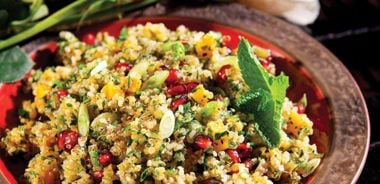Herbed Quinoa with Dried Apricots and Pomegranate

serves 2
Quinoa is not only high in protein, but it’s also a complete protein that includes all nine essential amino acids. The pomegranate arils (seeds) are a powerhouse source of antioxidants, fibre and vitamins C and K.
3 tsp (15 ml) extra-virgin olive oil, divided
1 small onion, diced
1/3 cup (80 ml) quinoa
2/3 cup (160 ml) vegetable stock
1 1/2 Tbsp (30 ml) diced dried apricots
2 Tbsp + 1 tsp (45 ml) pomegranate seeds
3 tsp (15 ml) chopped fresh mint
3 tsp (15 ml) chopped fresh coriander
1/2 Tbsp (30 ml) chopped fresh parsley
1 green onion, trimmed and finely sliced
Pinch ground cinnamon
1/2 tsp (2 ml) finely grated lemon zest
Pinch salt
Freshly ground black pepper, to taste
1. Heat 1 tsp (5 ml) olive oil in medium-sized saucepan over medium heat.
2. Add onion and sauté, stirring frequently, until golden brown, about 10 minutes.
3. Stir in quinoa and vegetable stock and bring to a boil. Cover, reduce heat to a simmer and cook for 10 minutes.
4. Turn the heat off, keeping saucepan covered and on burner, allowing the residual heat to continue cooking quinoa until all liquid has been absorbed, about 4 minutes. If there is still a little bit of water that has not been absorbed, leave saucepan covered on burner for another 3 to 5 minutes.
5. Meanwhile, in small bowl, pour enough hot tap water over apricots to just cover them. Soak for 5 minutes, then drain.
6. Remove quinoa from burner and stir in remaining 2 tsp (10 ml) olive oil, apricots, pomegranate seeds, mint, coriander, parsley, green onion, cinnamon, lemon zest, salt and black pepper. Serve warm or at room temperature.
Each serving contains: 833 kilojoules; 5 g protein; 9 g total fat (1 g sat. fat, 0 g trans fat); 26 g carbohydrates; 4 g fibre; 76 mg salt
source: "Be Mine, Vegetarian Valentine", alive Australia #14, Summer 2013





